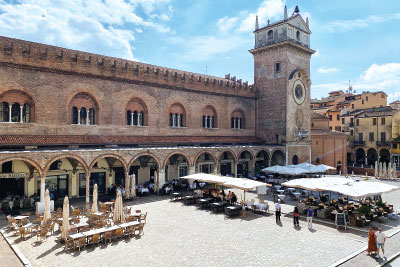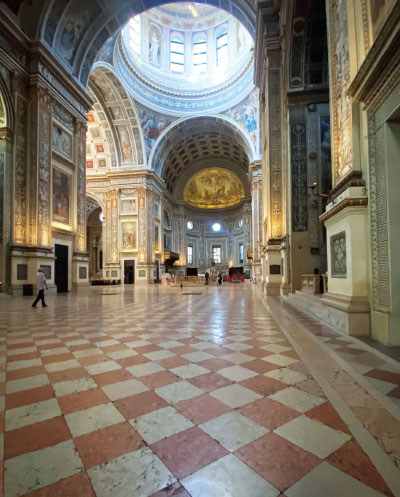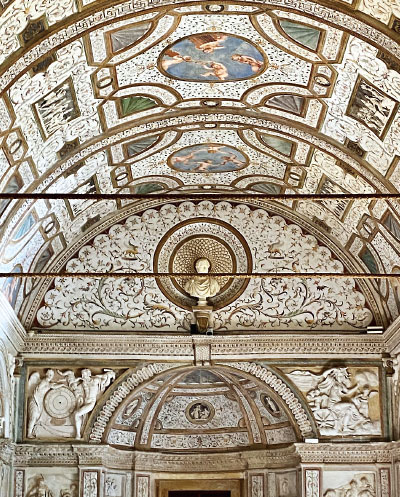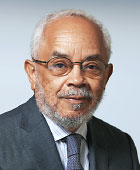A Migrant in the Midst of Mantuan Opulence
Abstract
Most of us have heard of the Italian city serving as an iconic symbol of high fashion, international sports, and world-class opera. Mantua, the English term for Mantova, located a mere couple of hours travel from Milan, is set in another world altogether. The taxi I boarded at the train station took me to the middle of a beautiful city square called Piazza Erbe and left me to walk about 50 yards to the hotel registration desk. Once done, I ambled over to the hotel room set up in another building. I paused on the ground floor to watch a couple of sous-chefs make pasta from scratch. Later in the evening, I would taste what they were making, the lightly sweetened pumpkin dish called tortelli di zucca.

Mantua’s Piazza Erbe has a 15th-century clock that marks the phases of the moon and signs of the zodiac.
From my room balcony, I could easily survey the Piazza Erbe, which remains the site of a weekly city market. The restaurants and cafes that delimit the periphery of the square were illuminated by lighted table candles as the sun went down. They also served as a backdrop for pedestrians strolling by on the cobbled streets. I felt I was somewhere special. Its 2,000-year history and place on the list of World Heritage Sites convinced me I was visiting Mantua much too late in life. In high school back in Barbados, I had translated simple Latin passages of Virgil, the Mantuan poet. I had also come across Monteverdi’s music in my choral experiences. All that had happened, however, without my making a connection to this city renowned for its art and culture. When I joined friends later for dinner, we could not stop talking about the magical ambience around us. The usual urban rush of traffic was gone; car horns silenced. Our only urgent concern was deciding which pasta to select. Fifty yards away, people held hands as they strolled around. There was a hushed quiet; people seemed to be loving life.

The interior of the Basilica of St. Andrew in Mantua, Italy, is admired for its early Renaissance design.
My tourist visits started with a promenade through the San Lorenza Rotunda, an 11th-century circular church at one end of the city square. Across the street stood proudly the Basilica Sant’Andrea (Basilica of St. Andrew), with its imposing steps. The grandeur of the church has made it an outstanding example of Renaissance architecture constructed between 1472 and 1765. The striking front façade of the church sets a contrast with the internal flooring of white and red marble arranged in checkerboard fashion. There is a crypt, located below the magnificent dome and at the intersection of the basilica’s nave and transept, that holds vessels said to contain the blood of Christ. Reportedly, the Roman soldier who pierced the side of Christ on the cross collected the blood and transported it to Mantua. The relic is exhibited in an annual street procession through Mantua on Good Friday.
The wondrous beauty of St. Andrew’s Basilica made me think again about how much pomp and majesty are required for the execution of sincere religious rituals. I recognize the complexity of my own question, calling to mind a long-ago conversation with a member of a church. She explained that the poverty of her church’s members could not stop them from finding different articles with which to decorate their church’s altar. That special sacred space in their church had to “look pretty.” It made them feel good and confident that their generosity toward the Almighty would be repaid. In our exchange, we never got to the problem of how much decoration is sufficient for the task of praising and pleasing God.

Above is a photo of the ceiling and doorway in a gallery of the Ducal Palace in Mantua, Italy.
Another day on a morning walk, I was mulling over the historic dominance of the Gonzaga family, who were so influential in the Renaissance extension of Mantua and its artistic flowering. They had caused exceptional artwork to be produced in the family’s palaces (the Palazzo Ducale and the Palazzo Te). I encountered a young man who greeted me in halting Italian. For our mutual comfort, we soon switched to English. He asked for help to buy other food to supplement the bag of rice he was carrying. He was an African migrant who had come seeking employment, and he explained that although jobs were hard to come by, he hoped to find work soon. His hardship seemed to blight the value of the Gonzagas’ contributions to the Italian patrimony. With the flamboyance of the Italian Renaissance, can we leave invisible the immigrant’s plight in our midst? Is there a way for the financially disadvantaged among us to benefit from the Gonzaga beneficence?
Someone brought to my attention a report in Le Monde (September 25, 2023), written by Sarah Belouezzane and Gilles Rof (“L’Appel Vibrant du Pape en Faveur des Migrants” – “The Pope’s Fervent Call on Behalf of Migrants”). On a recent visit to Marseille, France, the Pope seemed to respond directly to my reflections and concerns, making clear that the immigration problem is a major humanitarian and political quandary of the day. He recognized that seeking solutions with mere words is wasteful. People in the lower ranks of populations worldwide are seeking a better life, and that must be acknowledged. Underneath the search, which is sucking the life out of so many, is the quest for human dignity. This struggle, structured in modern terms by leaders of the developed countries, makes clear that we must ask how may everybody benefit from the advances made by the upper echelons? Leaving the lower classes to fend for themselves is unacceptable and undignified. Many of us understand that action is required, of course. Still, implementing solutions in this era of polarized political convention is a major task. ■




